(en) Making the neck. Carving off unnecessary corners. This is same method for making a round bar from a square bar. Drawing lines on the both sides of the corner which you want to carve off. And carve off the inside of this two lines. we can adjust the form easily and avoid cutting too much in this way.
(fr) Fabrique le manche en enlevant les coins inutiles. C’est la même méthode pour faire une barre ronde d’une barre carrée.
On trace des lignes aux deux côtés du coin où on veut enlève. Et enlève l’intérieur de ces deux lignes. Avec cette méthode, ce n’est pas difficile pour ajuster la forme et éviter de trop couper.
(jp) ネックを削る。角棒から丸棒を作るのと同じ要領で要らない角を落としていく。落としたい角の両脇に線を引いて、その線と線の内側を削るようにしていけば削りすぎないで済むよ。
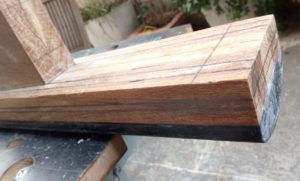
(en) Draw a new line as above each time, and repeat it until you get the nice shape.
(fr) Trace les nouvelles lignes comme ci-dessus à chaque fois. Et on le répète jusqu’à ce que on a la belle forme.
(jp) 削る毎に上記の要領で新しい線を引いていって好みのシェイプになるまで削る。
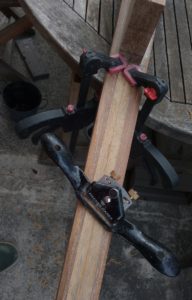
(en) I used the tools shown in the photo plus saw rasp.
(fr) J’utilise les outils comme sur la photo plus une râpe-scie.
(jp) とりあえず写真に写ってる様な道具を使った。これにプラスしてノコヤスリ。
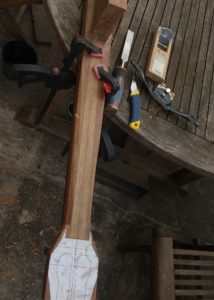
(en) I think it is very important to be able to fix the neck tightly. I fixed it like this.
(fr) Je pense que c’est très important de pouvoir bien fixer le manche. Je le fais comme ça.
(jp) ネックをしっかり固定できる様にするのが大事だと思う。こんな感じで固定。
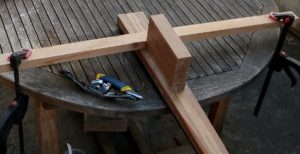
(en) Use sandpaper to smooth out the unevenness when the neck have rough shape.I often use a belt sander’s one for this kind of form. It works nicely because it has flexibility in the long direction and less flexibility in the short direction.
(fr) Utilise du papier de verre pour lisser les inégalités quand le manche en a la forme grossièrement.J’utilise souvent celle d’une ponceuse à bande pour ce type de forme. Cela fonctionne bien parce qu’il a une flexibilité dans le sens long et moins de flexibilité dans le sens court..
(jp) 一通りのカタチが出来たらヤスリで段差をなくして滑らかにするこういうのにはオイラはベルトサンダー用のヤツを使う事が多い。というのも、長い方向には柔軟性があって短い方向にはコシがあるからこういうカタチには適してると思う。
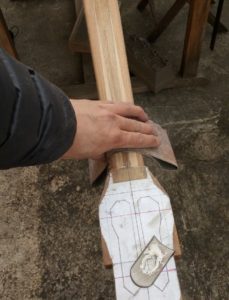
(en) I also use sandpaper that is wrapping around a flat wood board.
(fr) J’utilise également du papier de verre qui s’enroule autour d’une planche de bois plate.
(jp) 上のに合わせて、板にグルっと巻きつけて平面を出した紙やすりも良く使う。
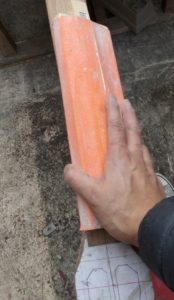
(en) Roughly done. I tried to scrape it as less as possible. It is for the sound character. But I don’t know yet if it is comfortable to play. So I will see later if it is necessary to scrape more or not.
(fr) À peu près terminé. J’ai essayé de le tailler le moins possible. C’est pour le caractère du son. Mais je ne sais pas encore s’il est confortable pour jouer. Je verrai plus tard s’il faut tailler en plus ou pas.
(jp) 大雑把に完成。音色の為に、なるべく削らないようにしたんだけど、弾きにくいかも知れないから、また後で必要があれば要らないトコロは削る感じ。
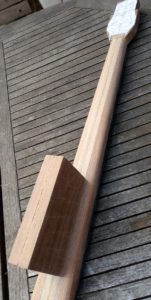
(en) The head next. Roughly cut with a saw.
(fr) La tête ensuite. Couper grossièrement avec une scie.
(jp) 次はヘッド。要らないところはまず大雑把にノコで切り取る。
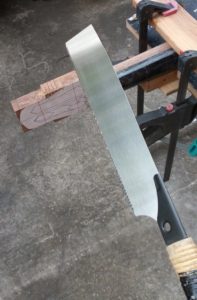
(en) For the point that is difficult to cut with a saw in the standard way. Put a saw perpendicular to the direction we want to cut as I wrote last post. Then cut off with a chisel.
(fr) Pour le point qui est difficile à couper avec une scie à la manière standard, place la scie perpendiculairement à la direction dans laquelle on veut couper comme j’ai écrit au dernier article. Puis enlève avec un ciseau.
(jp) ノコで切りにくいところは前回も書いたように切りたい方向に対して垂直にノコを入れてあとからノミで切り取ってく。
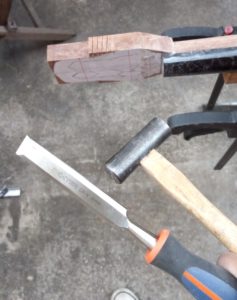
(en) We can cut it out like this.
(fr) On peut l’enlever comme ça.
(jp) こういう感じで切り取れる。
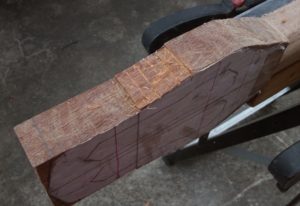
(en) Roughly done for the overall shape. Next is preparation for installation tuning machines.
(fr) À peu près terminé pour la forme globale. Ensuite préparation pour installation les mécaniques.
(jp) 大雑把に切り取り完了。次はペグをつける段取り。
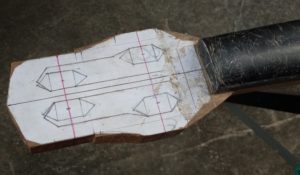
(en) Preparation for drilling the hole for the machine shaft. Mark the position with the red line that I put on the head’s front side . Next, using a compass for drawing a line on the side. The holes will be where the lines crossed.
(fr) Préparation au perçage du trou pour les arbres de la machine. Marquer la position avec la ligne rouge qui j’ai placé sur le devant de la tête. Ensuite, utiliser une boussole pour tracer une ligne sur le côté. Les trous seront là où les lignes se croisent.
(jp) ペグの軸が通るところの穴あけの段取り。ヘッドの正面から見た位置で印をつけて、後にコンパスで正面から見て奥行き何センチのトコロか?をマーク。これはコンパスでグルっと一周線を引いてしまえばラク。その線が重なったところが穴を開ける点、と。
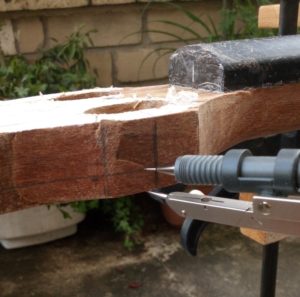
(en) Before drilling, make a small snap dent to avoid slipping the drill blade. Anything sharp will be OK.
(fr) Avant de percer, créer un petit bosse pour éviter de se glisser la lame de perceuse. Tout ce qui est aigu sera OK.
(jp) 穴あけ前にまずドリルの刃がブレないようにポチッとしとく。これは尖ってるものだったら何でもOK。
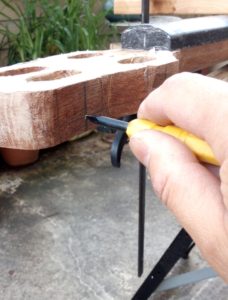
(en) Let’s drill!
(fr) perçons!
(jp) いざ、ドリる!
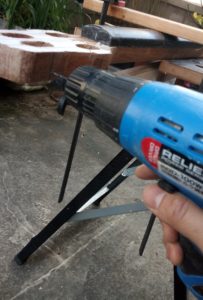
(en) I think it’s not too much difficult to make a straight hole. If it will be 90 degrees from the side and 90 degrees from the top, it is naturally done. There is some very small tolerance, but it is negligible. We need to get used to it, but this is much more simpler because we don’t need special tools.
The picture is the view from the side.
(fr) Je pense que ce n’est pas trop difficile de faire un trou droit. Si ce sera à 90 degrés du côté et à 90 degrés du haut, c’est naturellement fait. Il y a une très petite tolérance, mais c’est négligeable. Il faut habituer, mais c’est beaucoup plus simple parce qu’on n’a pas besoin d’outils special.
L’image est la vue de côté.
(jp) まっすぐ穴を開けるのって実はそんなに難しくなくって、真横から見て90度、真上から見て90度だったら自然になるんだ。多少誤差はでるけど全然気にならない範囲だよ。慣れは必要だけど、いちいち道具使わなくっていいからこの方がラク。
写真は真横からみた図。
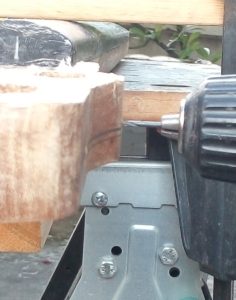
(en) View from above. In this case, I already had a red line that has been drawn on the pasted paper. I make a straight line with the drill’s blade with this line.
(fr) Vue d’en haut. Cette fois, j’ai déjà eu une ligne rouge qui a été dessinée sur le papier collé. Je mets la lame de la perceuse en faisant une ligne droite avec celà.
(jp) 真上から見た図。この場合、貼り付けた紙に線が引いてあるから、それとまっすぐになるように…という感じでも見ればさらにラク。

(en) Use the blades of different sizes to enlarge the hole little by little. If the first one is very straight, we don’t have to fix it after. Then let the blade goes in naturally.
I fitted the holes with the blade shown in the photo.
(fr) Utilise les lames des tailles différentes pour agrandir le trou petit à petit. Si le premier est très bien droit, on n’a pas le corriger après. Alors laisser avancer la lame naturellement.
J’ai ajusté les trous avec de la lame montrée sur la photo.
(jp) 違うサイズの刃を使って少しづつ穴を広げる。最初の下穴がちゃんとまっすぐしてると修正しないで済むので、刃が進んでいくのにまかせてドリルで切っていけば良いだけ。穴のサイズの調整の為に写真の様なヤツも使用。
